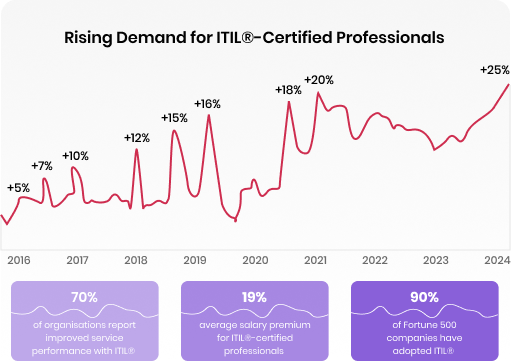ITIL® Practitioner Level
ITIL® Practitioner Level Courses build on foundational knowledge, focusing on applying ITIL® concepts in real-world scenarios. They equip professionals with practical tools for continual service improvement, stakeholder communication, and change adoption. It’s the essential next step for enhancing IT service delivery skills.
Browse Courses
ITIL® Practitioner
Duration: 2 Days

- Buxton
- Corby
- Derby
- Hinckley
- Leicester
- Lincoln
- Northampton
- Nottingham
- Birmingham
- Burton Upon Trent
- Coventry
- Solihull
- Stoke-on-Trent
- Warwick
- Wolverhampton
- Worcester
- Darlington
- Middlesbrough
- Newcastle
- Sunderland
- Carlisle
- Doncaster
- Harrogate
- Kingston upon Hull
- Leeds
- Sheffield
- Wakefield
- York
- Teesside
- Bath
- Bristol
- Cirencester
- Exeter
- Gloucester
- Plymouth
- Swindon
- Bournemouth
- Poole
- Brighton
- Canterbury
- Chatham
- Chichester
- Maidstone
- Portsmouth
- Southampton
- Tonbridge
- Jersey
- Bedford
- Luton
- Watford
- Bromley
- London
- Bracknell
- Milton Keynes
- Fleet
- Guildford
- High Wycombe
- Oxford
- Reading
- Slough
- Windsor Town
- Wokingham
- Gatwick
- Virtuals
- Heathrow
- Cambridge
- Chelmsford
- Colchester
- Ipswich
- Norwich
- Peterborough
- Bolton
- Chester
- Chorley
- Crewe
- Liverpool
- Manchester
- Preston
- Warrington
- Aberdeen
- Dundee
- Dunfermline
- Edinburgh
- Glasgow
- Inverness
- Cardiff
- Swansea
- Wrexham
- Belfast
- Dublin
- Buxton
- Corby
- Derby
- Hinckley
- Leicester
- Lincoln
- Northampton
- Nottingham
- Birmingham
- Burton Upon Trent
- Coventry
- Solihull
- Stoke-on-Trent
- Warwick
- Wolverhampton
- Worcester
- Darlington
- Middlesbrough
- Newcastle
- Sunderland
- Carlisle
- Doncaster
- Harrogate
- Kingston upon Hull
- Leeds
- Sheffield
- Wakefield
- York
- Teesside
- Bath
- Bristol
- Cirencester
- Exeter
- Gloucester
- Plymouth
- Swindon
- Bournemouth
- Poole
- Brighton
- Canterbury
- Chatham
- Chichester
- Maidstone
- Portsmouth
- Southampton
- Tonbridge
- Jersey
- Bedford
- Luton
- Watford
- Bromley
- London
- Bracknell
- Milton Keynes
- Fleet
- Guildford
- High Wycombe
- Oxford
- Reading
- Slough
- Windsor Town
- Wokingham
- Gatwick
- Virtuals
- Heathrow
- Cambridge
- Chelmsford
- Colchester
- Ipswich
- Norwich
- Peterborough
- Bolton
- Chester
- Chorley
- Crewe
- Liverpool
- Manchester
- Preston
- Warrington
- Aberdeen
- Dundee
- Dunfermline
- Edinburgh
- Glasgow
- Inverness
- Cardiff
- Swansea
- Wrexham
- Belfast
- Dublin
- Buxton
- Corby
- Derby
- Hinckley
- Leicester
- Lincoln
- Northampton
- Nottingham
- Birmingham
- Burton Upon Trent
- Coventry
- Solihull
- Stoke-on-Trent
- Warwick
- Wolverhampton
- Worcester
- Darlington
- Middlesbrough
- Newcastle
- Sunderland
- Carlisle
- Doncaster
- Harrogate
- Kingston upon Hull
- Leeds
- Sheffield
- Wakefield
- York
- Teesside
- Bath
- Bristol
- Cirencester
- Exeter
- Gloucester
- Plymouth
- Swindon
- Bournemouth
- Poole
- Brighton
- Canterbury
- Chatham
- Chichester
- Maidstone
- Portsmouth
- Southampton
- Tonbridge
- Jersey
- Bedford
- Luton
- Watford
- Bromley
- London
- Bracknell
- Milton Keynes
- Fleet
- Guildford
- High Wycombe
- Oxford
- Reading
- Slough
- Windsor Town
- Wokingham
- Gatwick
- Virtuals
- Heathrow
- Cambridge
- Chelmsford
- Colchester
- Ipswich
- Norwich
- Peterborough
- Bolton
- Chester
- Chorley
- Crewe
- Liverpool
- Manchester
- Preston
- Warrington
- Aberdeen
- Dundee
- Dunfermline
- Edinburgh
- Glasgow
- Inverness
- Cardiff
- Swansea
- Wrexham
- Belfast
- Dublin
- Buxton
- Corby
- Derby
- Hinckley
- Leicester
- Lincoln
- Northampton
- Nottingham
- Birmingham
- Burton Upon Trent
- Coventry
- Solihull
- Stoke-on-Trent
- Warwick
- Wolverhampton
- Worcester
- Darlington
- Middlesbrough
- Newcastle
- Sunderland
- Carlisle
- Doncaster
- Harrogate
- Kingston upon Hull
- Leeds
- Sheffield
- Wakefield
- York
- Teesside
- Bath
- Bristol
- Cirencester
- Exeter
- Gloucester
- Plymouth
- Swindon
- Bournemouth
- Poole
- Brighton
- Canterbury
- Chatham
- Chichester
- Maidstone
- Portsmouth
- Southampton
- Tonbridge
- Jersey
- Bedford
- Luton
- Watford
- Bromley
- London
- Bracknell
- Milton Keynes
- Fleet
- Guildford
- High Wycombe
- Oxford
- Reading
- Slough
- Windsor Town
- Wokingham
- Gatwick
- Virtuals
- Heathrow
- Cambridge
- Chelmsford
- Colchester
- Ipswich
- Norwich
- Peterborough
- Bolton
- Chester
- Chorley
- Crewe
- Liverpool
- Manchester
- Preston
- Warrington
- Aberdeen
- Dundee
- Dunfermline
- Edinburgh
- Glasgow
- Inverness
- Cardiff
- Swansea
- Wrexham
- Belfast
- Dublin
- Buxton
- Corby
- Derby
- Hinckley
- Leicester
- Lincoln
- Northampton
- Nottingham
- Birmingham
- Burton Upon Trent
- Coventry
- Solihull
- Stoke-on-Trent
- Warwick
- Wolverhampton
- Worcester
- Darlington
- Middlesbrough
- Newcastle
- Sunderland
- Carlisle
- Doncaster
- Harrogate
- Kingston upon Hull
- Leeds
- Sheffield
- Wakefield
- York
- Teesside
- Bath
- Bristol
- Cirencester
- Exeter
- Gloucester
- Plymouth
- Swindon
- Bournemouth
- Poole
- Brighton
- Canterbury
- Chatham
- Chichester
- Maidstone
- Portsmouth
- Southampton
- Tonbridge
- Jersey
- Bedford
- Luton
- Watford
- Bromley
- London
- Bracknell
- Milton Keynes
- Fleet
- Guildford
- High Wycombe
- Oxford
- Reading
- Slough
- Windsor Town
- Wokingham
- Gatwick
- Virtuals
- Heathrow
- Cambridge
- Chelmsford
- Colchester
- Ipswich
- Norwich
- Peterborough
- Bolton
- Chester
- Chorley
- Crewe
- Liverpool
- Manchester
- Preston
- Warrington
- Aberdeen
- Dundee
- Dunfermline
- Edinburgh
- Glasgow
- Inverness
- Cardiff
- Swansea
- Wrexham
- Belfast
- Dublin
- Buxton
- Corby
- Derby
- Hinckley
- Leicester
- Lincoln
- Northampton
- Nottingham
- Birmingham
- Burton Upon Trent
- Coventry
- Solihull
- Stoke-on-Trent
- Warwick
- Wolverhampton
- Worcester
- Darlington
- Middlesbrough
- Newcastle
- Sunderland
- Carlisle
- Doncaster
- Harrogate
- Kingston upon Hull
- Leeds
- Sheffield
- Wakefield
- York
- Teesside
- Bath
- Bristol
- Cirencester
- Exeter
- Gloucester
- Plymouth
- Swindon
- Bournemouth
- Poole
- Brighton
- Canterbury
- Chatham
- Chichester
- Maidstone
- Portsmouth
- Southampton
- Tonbridge
- Jersey
- Bedford
- Luton
- Watford
- Bromley
- London
- Bracknell
- Milton Keynes
- Fleet
- Guildford
- High Wycombe
- Oxford
- Reading
- Slough
- Windsor Town
- Wokingham
- Gatwick
- Virtuals
- Heathrow
- Cambridge
- Chelmsford
- Colchester
- Ipswich
- Norwich
- Peterborough
- Bolton
- Chester
- Chorley
- Crewe
- Liverpool
- Manchester
- Preston
- Warrington
- Aberdeen
- Dundee
- Dunfermline
- Edinburgh
- Glasgow
- Inverness
- Cardiff
- Swansea
- Wrexham
- Belfast
- Dublin
- Buxton
- Corby
- Derby
- Hinckley
- Leicester
- Lincoln
- Northampton
- Nottingham
- Birmingham
- Burton Upon Trent
- Coventry
- Solihull
- Stoke-on-Trent
- Warwick
- Wolverhampton
- Worcester
- Darlington
- Middlesbrough
- Newcastle
- Sunderland
- Carlisle
- Doncaster
- Harrogate
- Kingston upon Hull
- Leeds
- Sheffield
- Wakefield
- York
- Teesside
- Bath
- Bristol
- Cirencester
- Exeter
- Gloucester
- Plymouth
- Swindon
- Bournemouth
- Poole
- Brighton
- Canterbury
- Chatham
- Chichester
- Maidstone
- Portsmouth
- Southampton
- Tonbridge
- Jersey
- Bedford
- Luton
- Watford
- Bromley
- London
- Bracknell
- Milton Keynes
- Fleet
- Guildford
- High Wycombe
- Oxford
- Reading
- Slough
- Windsor Town
- Wokingham
- Gatwick
- Virtuals
- Heathrow
- Cambridge
- Chelmsford
- Colchester
- Ipswich
- Norwich
- Peterborough
- Bolton
- Chester
- Chorley
- Crewe
- Liverpool
- Manchester
- Preston
- Warrington
- Aberdeen
- Dundee
- Dunfermline
- Edinburgh
- Glasgow
- Inverness
- Cardiff
- Swansea
- Wrexham
- Belfast
- Dublin
- Buxton
- Corby
- Derby
- Hinckley
- Leicester
- Lincoln
- Northampton
- Nottingham
- Birmingham
- Burton Upon Trent
- Coventry
- Solihull
- Stoke-on-Trent
- Warwick
- Wolverhampton
- Worcester
- Darlington
- Middlesbrough
- Newcastle
- Sunderland
- Carlisle
- Doncaster
- Harrogate
- Kingston upon Hull
- Leeds
- Sheffield
- Wakefield
- York
- Teesside
- Bath
- Bristol
- Cirencester
- Exeter
- Gloucester
- Plymouth
- Swindon
- Bournemouth
- Poole
- Brighton
- Canterbury
- Chatham
- Chichester
- Maidstone
- Portsmouth
- Southampton
- Tonbridge
- Jersey
- Bedford
- Luton
- Watford
- Bromley
- London
- Bracknell
- Milton Keynes
- Fleet
- Guildford
- High Wycombe
- Oxford
- Reading
- Slough
- Windsor Town
- Wokingham
- Gatwick
- Virtuals
- Heathrow
- Cambridge
- Chelmsford
- Colchester
- Ipswich
- Norwich
- Peterborough
- Bolton
- Chester
- Chorley
- Crewe
- Liverpool
- Manchester
- Preston
- Warrington
- Aberdeen
- Dundee
- Dunfermline
- Edinburgh
- Glasgow
- Inverness
- Cardiff
- Swansea
- Wrexham
- Belfast
- Dublin
- Buxton
- Corby
- Derby
- Hinckley
- Leicester
- Lincoln
- Northampton
- Nottingham
- Birmingham
- Burton Upon Trent
- Coventry
- Solihull
- Stoke-on-Trent
- Warwick
- Wolverhampton
- Worcester
- Darlington
- Middlesbrough
- Newcastle
- Sunderland
- Carlisle
- Doncaster
- Harrogate
- Kingston upon Hull
- Leeds
- Sheffield
- Wakefield
- York
- Teesside
- Bath
- Bristol
- Cirencester
- Exeter
- Gloucester
- Plymouth
- Swindon
- Bournemouth
- Poole
- Brighton
- Canterbury
- Chatham
- Chichester
- Maidstone
- Portsmouth
- Southampton
- Tonbridge
- Jersey
- Bedford
- Luton
- Watford
- Bromley
- London
- Bracknell
- Milton Keynes
- Fleet
- Guildford
- High Wycombe
- Oxford
- Reading
- Slough
- Windsor Town
- Wokingham
- Gatwick
- Virtuals
- Heathrow
- Cambridge
- Chelmsford
- Colchester
- Ipswich
- Norwich
- Peterborough
- Bolton
- Chester
- Chorley
- Crewe
- Liverpool
- Manchester
- Preston
- Warrington
- Aberdeen
- Dundee
- Dunfermline
- Edinburgh
- Glasgow
- Inverness
- Cardiff
- Swansea
- Wrexham
- Belfast
- Dublin
- Buxton
- Corby
- Derby
- Hinckley
- Leicester
- Lincoln
- Northampton
- Nottingham
- Birmingham
- Burton Upon Trent
- Coventry
- Solihull
- Stoke-on-Trent
- Warwick
- Wolverhampton
- Worcester
- Darlington
- Middlesbrough
- Newcastle
- Sunderland
- Carlisle
- Doncaster
- Harrogate
- Kingston upon Hull
- Leeds
- Sheffield
- Wakefield
- York
- Teesside
- Bath
- Bristol
- Cirencester
- Exeter
- Gloucester
- Plymouth
- Swindon
- Bournemouth
- Poole
- Brighton
- Canterbury
- Chatham
- Chichester
- Maidstone
- Portsmouth
- Southampton
- Tonbridge
- Jersey
- Bedford
- Luton
- Watford
- Bromley
- London
- Bracknell
- Milton Keynes
- Fleet
- Guildford
- High Wycombe
- Oxford
- Reading
- Slough
- Windsor Town
- Wokingham
- Gatwick
- Virtuals
- Heathrow
- Cambridge
- Chelmsford
- Colchester
- Ipswich
- Norwich
- Peterborough
- Bolton
- Chester
- Chorley
- Crewe
- Liverpool
- Manchester
- Preston
- Warrington
- Aberdeen
- Dundee
- Dunfermline
- Edinburgh
- Glasgow
- Inverness
- Cardiff
- Swansea
- Wrexham
- Belfast
- Dublin
- Buxton
- Corby
- Derby
- Hinckley
- Leicester
- Lincoln
- Northampton
- Nottingham
- Birmingham
- Burton Upon Trent
- Coventry
- Solihull
- Stoke-on-Trent
- Warwick
- Wolverhampton
- Worcester
- Darlington
- Middlesbrough
- Newcastle
- Sunderland
- Carlisle
- Doncaster
- Harrogate
- Kingston upon Hull
- Leeds
- Sheffield
- Wakefield
- York
- Teesside
- Bath
- Bristol
- Cirencester
- Exeter
- Gloucester
- Plymouth
- Swindon
- Bournemouth
- Poole
- Brighton
- Canterbury
- Chatham
- Chichester
- Maidstone
- Portsmouth
- Southampton
- Tonbridge
- Jersey
- Bedford
- Luton
- Watford
- Bromley
- London
- Bracknell
- Milton Keynes
- Fleet
- Guildford
- High Wycombe
- Oxford
- Reading
- Slough
- Windsor Town
- Wokingham
- Gatwick
- Virtuals
- Heathrow
- Cambridge
- Chelmsford
- Colchester
- Ipswich
- Norwich
- Peterborough
- Bolton
- Chester
- Chorley
- Crewe
- Liverpool
- Manchester
- Preston
- Warrington
- Aberdeen
- Dundee
- Dunfermline
- Edinburgh
- Glasgow
- Inverness
- Cardiff
- Swansea
- Wrexham
- Belfast
- Dublin
- Buxton
- Corby
- Derby
- Hinckley
- Leicester
- Lincoln
- Northampton
- Nottingham
- Birmingham
- Burton Upon Trent
- Coventry
- Solihull
- Stoke-on-Trent
- Warwick
- Wolverhampton
- Worcester
- Darlington
- Middlesbrough
- Newcastle
- Sunderland
- Carlisle
- Doncaster
- Harrogate
- Kingston upon Hull
- Leeds
- Sheffield
- Wakefield
- York
- Teesside
- Bath
- Bristol
- Cirencester
- Exeter
- Gloucester
- Plymouth
- Swindon
- Bournemouth
- Poole
- Brighton
- Canterbury
- Chatham
- Chichester
- Maidstone
- Portsmouth
- Southampton
- Tonbridge
- Jersey
- Bedford
- Luton
- Watford
- Bromley
- London
- Bracknell
- Milton Keynes
- Fleet
- Guildford
- High Wycombe
- Oxford
- Reading
- Slough
- Windsor Town
- Wokingham
- Gatwick
- Virtuals
- Heathrow
- Cambridge
- Chelmsford
- Colchester
- Ipswich
- Norwich
- Peterborough
- Bolton
- Chester
- Chorley
- Crewe
- Liverpool
- Manchester
- Preston
- Warrington
- Aberdeen
- Dundee
- Dunfermline
- Edinburgh
- Glasgow
- Inverness
- Cardiff
- Swansea
- Wrexham
- Belfast
- Dublin
- Buxton
- Corby
- Derby
- Hinckley
- Leicester
- Lincoln
- Northampton
- Nottingham
- Birmingham
- Burton Upon Trent
- Coventry
- Solihull
- Stoke-on-Trent
- Warwick
- Wolverhampton
- Worcester
- Darlington
- Middlesbrough
- Newcastle
- Sunderland
- Carlisle
- Doncaster
- Harrogate
- Kingston upon Hull
- Leeds
- Sheffield
- Wakefield
- York
- Teesside
- Bath
- Bristol
- Cirencester
- Exeter
- Gloucester
- Plymouth
- Swindon
- Bournemouth
- Poole
- Brighton
- Canterbury
- Chatham
- Chichester
- Maidstone
- Portsmouth
- Southampton
- Tonbridge
- Jersey
- Bedford
- Luton
- Watford
- Bromley
- London
- Bracknell
- Milton Keynes
- Fleet
- Guildford
- High Wycombe
- Oxford
- Reading
- Slough
- Windsor Town
- Wokingham
- Gatwick
- Virtuals
- Heathrow
- Cambridge
- Chelmsford
- Colchester
- Ipswich
- Norwich
- Peterborough
- Bolton
- Chester
- Chorley
- Crewe
- Liverpool
- Manchester
- Preston
- Warrington
- Aberdeen
- Dundee
- Dunfermline
- Edinburgh
- Glasgow
- Inverness
- Cardiff
- Swansea
- Wrexham
- Belfast
- Dublin
- Buxton
- Corby
- Derby
- Hinckley
- Leicester
- Lincoln
- Northampton
- Nottingham
- Birmingham
- Burton Upon Trent
- Coventry
- Solihull
- Stoke-on-Trent
- Warwick
- Wolverhampton
- Worcester
- Darlington
- Middlesbrough
- Newcastle
- Sunderland
- Carlisle
- Doncaster
- Harrogate
- Kingston upon Hull
- Leeds
- Sheffield
- Wakefield
- York
- Teesside
- Bath
- Bristol
- Cirencester
- Exeter
- Gloucester
- Plymouth
- Swindon
- Bournemouth
- Poole
- Brighton
- Canterbury
- Chatham
- Chichester
- Maidstone
- Portsmouth
- Southampton
- Tonbridge
- Jersey
- Bedford
- Luton
- Watford
- Bromley
- London
- Bracknell
- Milton Keynes
- Fleet
- Guildford
- High Wycombe
- Oxford
- Reading
- Slough
- Windsor Town
- Wokingham
- Gatwick
- Virtuals
- Heathrow
- Cambridge
- Chelmsford
- Colchester
- Ipswich
- Norwich
- Peterborough
- Bolton
- Chester
- Chorley
- Crewe
- Liverpool
- Manchester
- Preston
- Warrington
- Aberdeen
- Dundee
- Dunfermline
- Edinburgh
- Glasgow
- Inverness
- Cardiff
- Swansea
- Wrexham
- Belfast
- Dublin
- Buxton
- Corby
- Derby
- Hinckley
- Leicester
- Lincoln
- Northampton
- Nottingham
- Birmingham
- Burton Upon Trent
- Coventry
- Solihull
- Stoke-on-Trent
- Warwick
- Wolverhampton
- Worcester
- Darlington
- Middlesbrough
- Newcastle
- Sunderland
- Carlisle
- Doncaster
- Harrogate
- Kingston upon Hull
- Leeds
- Sheffield
- Wakefield
- York
- Teesside
- Bath
- Bristol
- Cirencester
- Exeter
- Gloucester
- Plymouth
- Swindon
- Bournemouth
- Poole
- Brighton
- Canterbury
- Chatham
- Chichester
- Maidstone
- Portsmouth
- Southampton
- Tonbridge
- Jersey
- Bedford
- Luton
- Watford
- Bromley
- London
- Bracknell
- Milton Keynes
- Fleet
- Guildford
- High Wycombe
- Oxford
- Reading
- Slough
- Windsor Town
- Wokingham
- Gatwick
- Virtuals
- Heathrow
- Cambridge
- Chelmsford
- Colchester
- Ipswich
- Norwich
- Peterborough
- Bolton
- Chester
- Chorley
- Crewe
- Liverpool
- Manchester
- Preston
- Warrington
- Aberdeen
- Dundee
- Dunfermline
- Edinburgh
- Glasgow
- Inverness
- Cardiff
- Swansea
- Wrexham
- Belfast
- Dublin
- Buxton
- Corby
- Derby
- Hinckley
- Leicester
- Lincoln
- Northampton
- Nottingham
- Birmingham
- Burton Upon Trent
- Coventry
- Solihull
- Stoke-on-Trent
- Warwick
- Wolverhampton
- Worcester
- Darlington
- Middlesbrough
- Newcastle
- Sunderland
- Carlisle
- Doncaster
- Harrogate
- Kingston upon Hull
- Leeds
- Sheffield
- Wakefield
- York
- Teesside
- Bath
- Bristol
- Cirencester
- Exeter
- Gloucester
- Plymouth
- Swindon
- Bournemouth
- Poole
- Brighton
- Canterbury
- Chatham
- Chichester
- Maidstone
- Portsmouth
- Southampton
- Tonbridge
- Jersey
- Bedford
- Luton
- Watford
- Bromley
- London
- Bracknell
- Milton Keynes
- Fleet
- Guildford
- High Wycombe
- Oxford
- Reading
- Slough
- Windsor Town
- Wokingham
- Gatwick
- Virtuals
- Heathrow
- Cambridge
- Chelmsford
- Colchester
- Ipswich
- Norwich
- Peterborough
- Bolton
- Chester
- Chorley
- Crewe
- Liverpool
- Manchester
- Preston
- Warrington
- Aberdeen
- Dundee
- Dunfermline
- Edinburgh
- Glasgow
- Inverness
- Cardiff
- Swansea
- Wrexham
- Belfast
- Dublin
- Buxton
- Corby
- Derby
- Hinckley
- Leicester
- Lincoln
- Northampton
- Nottingham
- Birmingham
- Burton Upon Trent
- Coventry
- Solihull
- Stoke-on-Trent
- Warwick
- Wolverhampton
- Worcester
- Darlington
- Middlesbrough
- Newcastle
- Sunderland
- Carlisle
- Doncaster
- Harrogate
- Kingston upon Hull
- Leeds
- Sheffield
- Wakefield
- York
- Teesside
- Bath
- Bristol
- Cirencester
- Exeter
- Gloucester
- Plymouth
- Swindon
- Bournemouth
- Poole
- Brighton
- Canterbury
- Chatham
- Chichester
- Maidstone
- Portsmouth
- Southampton
- Tonbridge
- Jersey
- Bedford
- Luton
- Watford
- Bromley
- London
- Bracknell
- Milton Keynes
- Fleet
- Guildford
- High Wycombe
- Oxford
- Reading
- Slough
- Windsor Town
- Wokingham
- Gatwick
- Virtuals
- Heathrow
- Cambridge
- Chelmsford
- Colchester
- Ipswich
- Norwich
- Peterborough
- Bolton
- Chester
- Chorley
- Crewe
- Liverpool
- Manchester
- Preston
- Warrington
- Aberdeen
- Dundee
- Dunfermline
- Edinburgh
- Glasgow
- Inverness
- Cardiff
- Swansea
- Wrexham
- Belfast
- Dublin
- Buxton
- Corby
- Derby
- Hinckley
- Leicester
- Lincoln
- Northampton
- Nottingham
- Birmingham
- Burton Upon Trent
- Coventry
- Solihull
- Stoke-on-Trent
- Warwick
- Wolverhampton
- Worcester
- Darlington
- Middlesbrough
- Newcastle
- Sunderland
- Carlisle
- Doncaster
- Harrogate
- Kingston upon Hull
- Leeds
- Sheffield
- Wakefield
- York
- Teesside
- Bath
- Bristol
- Cirencester
- Exeter
- Gloucester
- Plymouth
- Swindon
- Bournemouth
- Poole
- Brighton
- Canterbury
- Chatham
- Chichester
- Maidstone
- Portsmouth
- Southampton
- Tonbridge
- Jersey
- Bedford
- Luton
- Watford
- Bromley
- London
- Bracknell
- Milton Keynes
- Fleet
- Guildford
- High Wycombe
- Oxford
- Reading
- Slough
- Windsor Town
- Wokingham
- Gatwick
- Virtuals
- Heathrow
- Cambridge
- Chelmsford
- Colchester
- Ipswich
- Norwich
- Peterborough
- Bolton
- Chester
- Chorley
- Crewe
- Liverpool
- Manchester
- Preston
- Warrington
- Aberdeen
- Dundee
- Dunfermline
- Edinburgh
- Glasgow
- Inverness
- Cardiff
- Swansea
- Wrexham
- Belfast
- Dublin
- Buxton
- Corby
- Derby
- Hinckley
- Leicester
- Lincoln
- Northampton
- Nottingham
- Birmingham
- Burton Upon Trent
- Coventry
- Solihull
- Stoke-on-Trent
- Warwick
- Wolverhampton
- Worcester
- Darlington
- Middlesbrough
- Newcastle
- Sunderland
- Carlisle
- Doncaster
- Harrogate
- Kingston upon Hull
- Leeds
- Sheffield
- Wakefield
- York
- Teesside
- Bath
- Bristol
- Cirencester
- Exeter
- Gloucester
- Plymouth
- Swindon
- Bournemouth
- Poole
- Brighton
- Canterbury
- Chatham
- Chichester
- Maidstone
- Portsmouth
- Southampton
- Tonbridge
- Jersey
- Bedford
- Luton
- Watford
- Bromley
- London
- Bracknell
- Milton Keynes
- Fleet
- Guildford
- High Wycombe
- Oxford
- Reading
- Slough
- Windsor Town
- Wokingham
- Gatwick
- Virtuals
- Heathrow
- Cambridge
- Chelmsford
- Colchester
- Ipswich
- Norwich
- Peterborough
- Bolton
- Chester
- Chorley
- Crewe
- Liverpool
- Manchester
- Preston
- Warrington
- Aberdeen
- Dundee
- Dunfermline
- Edinburgh
- Glasgow
- Inverness
- Cardiff
- Swansea
- Wrexham
- Belfast
- Dublin
- Buxton
- Corby
- Derby
- Hinckley
- Leicester
- Lincoln
- Northampton
- Nottingham
- Birmingham
- Burton Upon Trent
- Coventry
- Solihull
- Stoke-on-Trent
- Warwick
- Wolverhampton
- Worcester
- Darlington
- Middlesbrough
- Newcastle
- Sunderland
- Carlisle
- Doncaster
- Harrogate
- Kingston upon Hull
- Leeds
- Sheffield
- Wakefield
- York
- Teesside
- Bath
- Bristol
- Cirencester
- Exeter
- Gloucester
- Plymouth
- Swindon
- Bournemouth
- Poole
- Brighton
- Canterbury
- Chatham
- Chichester
- Maidstone
- Portsmouth
- Southampton
- Tonbridge
- Jersey
- Bedford
- Luton
- Watford
- Bromley
- London
- Bracknell
- Milton Keynes
- Fleet
- Guildford
- High Wycombe
- Oxford
- Reading
- Slough
- Windsor Town
- Wokingham
- Gatwick
- Virtuals
- Heathrow
- Cambridge
- Chelmsford
- Colchester
- Ipswich
- Norwich
- Peterborough
- Bolton
- Chester
- Chorley
- Crewe
- Liverpool
- Manchester
- Preston
- Warrington
- Aberdeen
- Dundee
- Dunfermline
- Edinburgh
- Glasgow
- Inverness
- Cardiff
- Swansea
- Wrexham
- Belfast
- Dublin
Industries That Rely on ITIL®
- Information Technology (IT)
- Finance & Banking
- Healthcare
- Telecommunications
- Government & Public Sector
- Retail & E-Commerce
- Education & E-Learning
About Wrexham
Wrexham is a major town in the north of Wales. It is an administrative, commercial, as well as an educational centre. Since 1996 it has been the centre of the Wrexham County Borough. Census in 2011 states that Wrexham had a total population of 61,603, making it the fourth largest urban area in Wales.
From Prehistoric to Roman times
Civilization in the Wrexham area is said to have been existing since the Mesolithic period (8000 to 4300 BC). By the early Middle Bronze Age it became an innovative metalworking industry.
Archeologists have revealed the presence of Roman civilian settlements in Plas Coch area of Wrexham. Also, finds have revealed proof of agriculture and trade with the wider Roman world.
Governance
The Wrexham constituency elects members to the UK Parliament and the National Assembly for Wales. The constituency consists of both the town and some of its distant villages such as Gwersyllt, Rossett, Llay, Holt and Marford.
It is considered as a safe seat for Labour Party for the UK’s Parliament. Wrexham is subdivided into the communities of Acton, Offa, Rhosddu and Caia Park.
Geography
Wrexham is not constructed on the main river but a flat plateau between easternmost mountains and the lower Dee Valley of North Wales. This position permitted it to develop as a market town, and later as an industrial hub due to its rich natural reserves of iron ore and coal.
But three minor rivers flow through parts of the town: the Gwenfro, Clywedog, and Alyn. Wrexham is known for the reserve of underground water’s quality, which gave way to the development of Wreexham as a major brewing centre.
ITIL® Training & Certification
Topic Introduction
ITIL® Practitioner Level Courses are designed to deepen your understanding of ITIL® concepts and demonstrate how to apply them effectively within a real-world business context. This level focuses on the practical application of the ITIL® framework to drive service improvement and maximise value.The ITIL® Practitioner Course bridges the gap between theory and practice. It offers essential guidance on “how to” adopt and adapt ITIL® for your organisation. With a strong emphasis on continual service improvement (CSI), organisational change management, and effective communication, this course prepares you to implement sustainable ITSM improvements. It includes expert-led training, official courseware, practical toolkits, and assessments to earn the ITIL® Practitioner Certification.The ITIL® Foundation Course is a prerequisite for becoming an ITIL® Practitioner and must be completed before pursuing practitioner-level training. Foundation introduces the core principles, while Practitioner empowers you to apply them confidently in your role.
Show More
Our Learning Delivery Options

Classroom Training
Learn in a traditional face-to-face setting at one of our global training centres. Classroom training offers a focused environment, peer interaction, and direct access to expert trainers, ideal for immersive, distraction-free learning.
Enquire Now

Online Instructor-Led Training
Join live virtual classrooms led by industry experts. Our online instructor-led training blends real-time interaction, expert guidance, and structured learning to deliver the classroom experience wherever you are. Ideal for professionals seeking flexibility without compromising quality.
Enquire Now

Online Self-Paced Training
Train on your own terms with 24/7 access to expert-developed course materials. Online self-paced learning is perfect for busy professionals who want the freedom to study anytime, anywhere, at their own pace.
Enquire Now

Onsite Training
Upskill your team with onsite training delivered at your location. Our expert instructors bring tailored course content to your workplace, helping reduce travel costs and align training with your organisational goals.
Enquire Now
Need Help Choosing the Right Delivery Format?
Whether you're comparing online vs classroom options or planning onsite training for your team, our ITIL® experts will guide you to the best fit. Get personalised advice now.
Top ITIL® Roles Leading Operational Excellence
- Oversees end-to-end service delivery aligned with ITIL best practices.
- Ensures consistent performance and continual improvement of IT Services.
- Bridges business goals and IT operations for maximum service value.
- Controls and coordinates all ITIL-defined change processes.
- Minimises service disruptions while implementing critical IT changes.
- Ensures risk assessment and stakeholder communication during transitions.
- Manages incident lifecycles to restore services quickly and efficiently.
- Reduces downtime by applying ITIL frameworks to real-time issues.
- Enhances user satisfaction through structured incident resolution.













Virtual Classroom Training
Join live, expert-led virtual classrooms that offer dedicated instructor support, enhanced convenience, and significant savings on travel and accommodation. Perfect for professionals seeking real-world skills without disrupting their work schedule.
Let’s Build a Tailored Training Solution for Your Team
To discuss bespoke corporate training courses, share your business goals using the form. From small teams to enterprise rollouts, we’ll help you upskill your workforce effectively.
Frequently Asked Questions?
The ITIL® Practitioner Course builds on the Foundation level by focusing on the practical application of ITIL® concepts. It provides essential guidance on adopting and adapting the ITIL® framework to drive continual service improvement within organisations.
This course is ideal for IT Professionals, Service Managers, Project Managers, and Change Agents who are responsible for managing or improving IT services and want to implement ITIL® best practices effectively.
Yes, delegates must hold the ITIL® Foundation Certification before taking the Practitioner Course, as it builds on the knowledge and principles introduced at the Foundation level.
The course covers organisational change management, communication, measurement and metrics, continual service improvement (CSI), and key tools and techniques for applying ITIL® practices in real-world scenarios.
Absolutely. It is designed for professionals who want to implement ITIL® practically and improve service quality, efficiency, and alignment with business goals in their day-to-day roles.
Yes, the ITIL® Practitioner Certification is globally recognised and demonstrates a professional’s ability to implement and tailor ITIL® practices for maximum business value.





 Back to
Topics
Back to
Topics

























